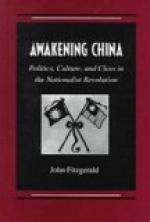[Page 33] CHAPTER VII
PROVINCE OF CHIHLI
Taku—Tientsin—Peking—The Summer Palace—Patachu—Temples of Heaven, Earth, and Agriculture—Foreign Quarter—The Forbidden City—King-Han Railway—Paoting-fu
Crossing the gulf we reach Taku, at the mouth of the Peiho, and, passing the dismantled forts, ascend the river to Tientsin.
In 1858 I spent two months at Taku and Tientsin in connection with the tedious negotiations of that year. At the latter place I became familiar with the dusty road to the treaty temple; and at the former witnessed the capture of the forts by the combined squadrons of Great Britain and France. The next year on the same ground I saw the allied forces repulsed with heavy loss—a defeat avenged by the capture of Peking in 1860.
In the Boxer War the relief force met with formidable opposition at Tientsin. The place has, however, risen with new splendour from its half-ruined condition, and now poses as the principal residence of the most powerful of the viceroys. Connected by the river with the seaboard, by the Grand Canal with several provinces to the south, and by rail with Peking, Hankow and Manchuria, Tientsin commands the chief lines of [Page 34] communication in northern China. In point of trade it ranks as the third in importance of the treaty ports.
Three hours by rail bring us to the gates of Peking, the northern capital. Formerly it took another hour to get within the city. Superstition or suspicion kept the railway station at a distance; now, however, it is at the Great Central Gate. Unlike Nanking, Peking has nothing picturesque or commanding in its location. On the west and north, at a distance of ten to twenty miles, ranges of blue hills form a feature in the landscape. Within these limits the eye rests on nothing but flat fields, interspersed with clumps of trees overshadowing some family cemetery or the grave of some grandee.
Between the city and the hills are the Yuen Ming Yuen, the Emperor’s summer palace, burnt in 1860 and still an unsightly ruin, and the Eho Yuen, the summer residence of the Empress Dowager. Enclosing two or three pretty hills and near to a lofty range, the latter occupies a site of rare beauty. It also possesses mountain water in rich abundance. No fewer than twenty-four springs gush from the base of one of its hills, feeding a pretty lake and numberless canals. Partly destroyed in 1860, this palace was for many years as silent as the halls of Palmyra. I have often wandered through its neglected grounds. Now, every prominent rock is crowned with pagoda or pavilion. There are, however, some things which the slave of the lamp is unable to produce even at the command of an empress—there are no venerable oaks or tall pines to lend their majesty to the scene.




